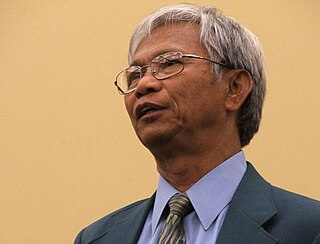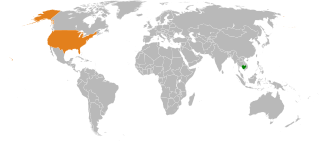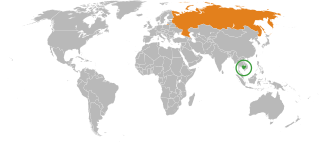
Phnom Penh is the capital and most populous city of Cambodia. It has been the national capital since the French protectorate of Cambodia and has grown to become the nation's primate city and its economic, industrial, and cultural centre. Before Phnom Penh became capital city, Oudong was the capital of the country.

Dith Pran was a Cambodian American photojournalist. He was a refugee and survivor of the Cambodian genocide and the subject of the film The Killing Fields (1984).

The Cambodian Civil War was a civil war in Cambodia fought between the forces of the Communist Party of Kampuchea against the government forces of the Kingdom of Cambodia and, after October 1970, the Khmer Republic, which had succeeded the kingdom.

Haing Somnang Ngor was a Cambodian-born American actor, gynecologist, and obstetrician. He won the Academy Award for Best Supporting Actor in 1985 for his debut performance in the film The Killing Fields (1984), in which he portrayed Cambodian journalist and refugee Dith Pran.

Sydney Hillel Schanberg was an American journalist who was best known for his coverage of the war in Cambodia. He was the recipient of a Pulitzer Prize, two George Polk awards, two Overseas Press Club awards, and the Sigma Delta Chi prize for distinguished journalism. Schanberg was portrayed by Sam Waterston in the 1984 film The Killing Fields based on the experiences of Schanberg and the Cambodian journalist Dith Pran in Cambodia.

The Killing Fields is a 1984 British biographical drama film about the Khmer Rouge regime in Cambodia, which is based on the experiences of two journalists: Cambodian Dith Pran and American Sydney Schanberg. It was directed by Roland Joffé and produced by David Puttnam for his company Goldcrest Films. Sam Waterston stars as Schanberg, Haing S. Ngor as Pran, and John Malkovich as Al Rockoff. The adaptation for the screen was written by Bruce Robinson; the musical score was written by Mike Oldfield and orchestrated by David Bedford.

François Bizot is a French anthropologist. While working as a conservationist in Cambodia, he was held captive by the Khmer Rouge for several months. He was released after being found innocent of spying charges, becoming the only Westerner to survive imprisonment by the Khmer Rouge.
Long Boret was a Cambodian politician who served as the last prime minister of the Khmer Republic from 26 December 1973, to 17 April 1975. Highly regarded for his honesty, he tried unsuccessfully to negotiate a peace settlement with the Khmer Rouge during the Cambodian Civil War. He was later arrested by the Khmer Rouge and executed. He is one of two prime ministers to die in office, the other being Chan Sy. He is also the longest serving prime minister under the presidency of Lon Nol for the Khmer Republic.

Cinema in Cambodia began in the 1950s, and many films were being screened in theaters throughout the country by the 1960s, which are regarded as the "golden age". After a near-disappearance during the Khmer Rouge regime, competition from video and television has meant that the Cambodian film industry is a small one.

Operation Eagle Pull was the United States military evacuation by air of Phnom Penh, Cambodia, on 12 April 1975. At the beginning of April 1975, Phnom Penh, one of the last remaining strongholds of the Khmer Republic, was surrounded by the Khmer Rouge and totally dependent on aerial resupply through Pochentong Airport. With a Khmer Rouge victory imminent, the US government made contingency plans for the evacuation of US nationals and allied Cambodians by helicopter to ships in the Gulf of Thailand. Operation Eagle Pull took place on the morning of 12 April 1975 and was a tactical success carried out without any loss of life. Five days later the Khmer Republic collapsed and the Khmer Rouge occupied Phnom Penh.

Bilateral relations between the United States and Cambodia, while strained throughout the Cold War, have strengthened considerably in modern times. The U.S. supports efforts in Cambodia to combat terrorism, build democratic institutions, promote human rights, foster economic development, eliminate corruption.

The Hotel Le Royal is a hotel located in Daun Penh District, Phnom Penh, Cambodia. It was first established in 1929. It is today operated by Raffles Hotels & Resorts.

Cambodia–Russia relations are the bilateral relations of Cambodia and Russia. The relations between both countries were strong since the Soviet era. Russia has an embassy in Phnom Penh. Cambodia has an embassy in Moscow. Both countries are full members of the East Asia Summit.

Cambodia–Vietnam relations take place in the form of bilateral relations between the Kingdom of Cambodia and the Socialist Republic of Vietnam. The countries have shared a land border for the last 1,000 years and share more recent historical links through being part of the French colonial empire. Both countries are members of the Association of Southeast Asian Nations (ASEAN).

François Ponchaud is a French Catholic priest and missionary to Cambodia. He is best known for his documentation of the genocide which occurred under the Khmer Rouge (KR), and for being one of the first people to expose the human rights abuses being carried out at the time.

The fall of Phnom Penh was the capture of Phnom Penh, capital of the Khmer Republic, by the Khmer Rouge on 17 April 1975, effectively ending the Cambodian Civil War. At the beginning of April 1975, Phnom Penh, one of the last remaining strongholds of the Khmer Republic, was surrounded by the Khmer Rouge and totally dependent on aerial resupply through Pochentong Airport.
The following lists events that happened during 1975 in Cambodia.
Vandy Rattana is a photographer and artist, now resident in Taiwan, whose work is concerned with Cambodian society.
The Embassy of France in Cambodia is the primary diplomatic mission of the French Republic to the Kingdom of Cambodia. It is located in the capital Phnom Penh. It is known for the role it played as a place of refuge for foreigners and at-risk Cambodians after the Khmer Rouge takeover for several days until foreigners were forced to go to Thailand while the regime forced Cambodians to stay in the country.

Cambodia–Germany relations are diplomatic relations between Cambodia and Germany. Diplomatic relations between the Federal Republic of Germany and Cambodia were established on October 3, 1993. The GDR had already maintained diplomatic relations with Cambodia since 1962.
















